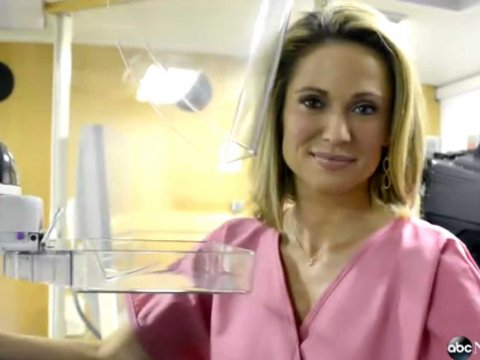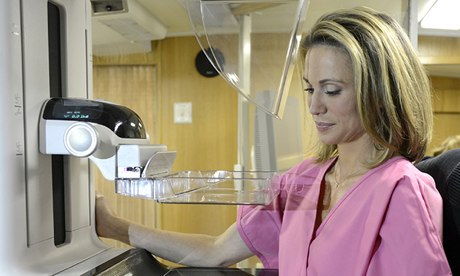Amy Robach, host of ABC’s Good Morning America, did the story of her life last month, literally. You see, Amy Robach turned 40 this year. Her producers and co-anchor, Robin Roberts, encouraged her to do a story about screening mammograms. In fact, Robin Roberts told her that if the story saved one life, it would be worth it. While reluctant to undergo a less than private mammogram for a news story, she agreed.

Amy Robach preparing for her first screening mammogram at age 40.
Mammography Guidelines
Doctors recommend an initial screening mammography at age 40. I have posted a few articles here confirming 40 as the best initial mammography screening age for women. The U.S. Preventive Services Task Force (USPSTF), a group convened by the government to save money, recommended 50 in their 1991 report. The American College of Radiology reviewed the same data that the USPSTF used, and found that the data supported initial mammograms at age 40. If Amy Robach had followed the USPSTF’s recommendations, her breast cancer would not have been diagnosed.
Amy’s Initial Fears
Amy remarked that the exam hurt much less than she thought it would. For most women age 40, the initial concerns with mammography center around the expected discomfort and embarrassment of the breast cancer screening exam, and the fear of having breast cancer. Breast cancer in women under age 40 accounts for less then 7% of all breast cancers, but individual risks vary. An early diagnosis is key in curative treatment for breast cancer.
Mammogram Follow-up Views
The screening mammogram is a screening test. Two views are taken of each breast, one up-and-down and one side-to-side. For women who have had Breast Augmentation, there is no increased risk of breast cancer; however, a third oblique view is often added to maximize the amount of breast tissue visualized on the exam.
When the breasts are dense, which is more common in younger women, it can be more difficult to read the mammogram. Sometimes a woman is called back to the Mammography Center to have additional views to check areas not well seen. This happened to Amy. She returned to the center for additional view, likely magnification views. These usually rule out suspicious areas, but in Amy’s case the additional views confirmed a mass suspicious for breast cancer.
The Next Step Towards Diagnosis and Cure
Suspicious lesions on a mammogram are not always breast cancer. The next step is obtaining cells to study. This may be accomplished with a core needle biopsy, or an open breast biopsy. Once removed, the cells are prepared, stained and examined under the microscope by a pathologist. For many women, the specimen is not breast cancer, and life returns to normal after a short recovery period.
When the Diagnosis is Breast Cancer
Sometime the diagnosis is Breast Cancer. While no one wants the diagnosis, 1 in 8 women will develop breast cancer during their lifetime. The difference between survivor and casualty is early diagnosis. Since breast cancer is not painful, it can grow silently. Breast Cancer screening has made a tremendous difference in surviving breast cancer. Early Diagnosis means smaller tumors, a reduced chance of the breast cancer spreading outside the breast and fewer complications with proper treatment.
How to Cure Breast Cancer
After making the diagnosis, removing the cancer cells provides the best chance for cure. We have many options today ranging from lumpectomy to mastectomy, and even prophylactic mastectomies like Angelina Jolie. Additionally, options for Breast Reconstruction provide comfort and a sense of completion for many women.

Amy Robach and the Mammography Machine that Helped Save her Life.
Double Mastectomy with Breast Reconstruction
Amy Robach decided to have a double mastectomy to cure her Breast Cancer and to reduce the risk of developing another Breast Cancer in the future. What started as an informational segment for Good Morning America has become a life extending turning point. The importance of Screening Mammography cannot be stressed enough. I cannot say it any better than Amy Robach did. “I got lucky by catching it early. I can only hope my story will … inspire every woman who hears it to get a mammogram, to take a self-exam. No excuses. It is the difference between life and death.”
Best of luck to you and your family, Amy.
Previous Post Next Post